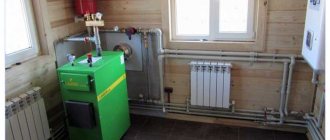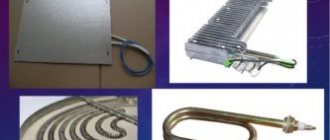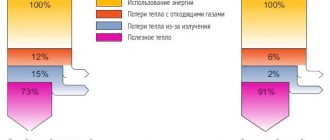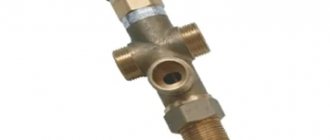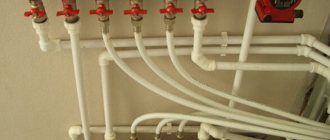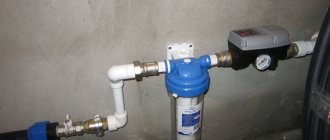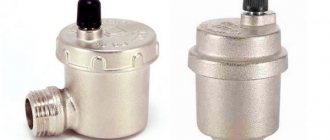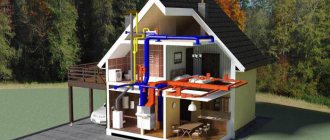Heat carriers (cooling fluids for heat exchange systems) are working media that, during the heat exchange process, either remove excess heat or are used for heating in various production technologies, as well as for heating residential, office and industrial buildings and structures.
To increase the efficiency of the heat exchange process in heating systems, different types of coolant fluids are used as working media. Initially, plain water or, in some cases, steam was used. Subsequently, such technologies lost their development as they became ineffective and expensive. Heat exchange equipment rusts quite quickly, the water has to be constantly changed, and cooling occurs too quickly.
In order to increase the operating efficiency of heat exchange equipment and improve the operation of heat exchange systems, new types of all-season low-freezing coolant compositions with long service life in heating systems have been developed.
At the present stage of development of industrial production, the most widely used working media for heat exchange systems are aqueous solutions of glycols (ethylene glycol, propylene glycol) or glycerin containing additive packages that improve their performance characteristics. Today these are the most efficient working media used in heat transfer processes.
There are many types of coolants, the physical and chemical characteristics of which differ slightly from each other, which makes it possible to choose the most suitable one, taking into account the conditions of its further use.
From this many types of popular coolants, the following most common groups can be roughly distinguished:
- water (water-salt solutions);
- ethylene glycol, propylene glycol (water-glycol solutions);
- mixtures.
Each of the coolants of these groups has its own characteristic advantages and disadvantages.
Characteristics of water as a heat conductor
Many heating systems are filled with water as a working medium - the most accessible and versatile coolant. It is freely available, and its reserves in nature are regularly renewed. Up to 70% of heating systems are filled with natural liquid.
The popularity of water is due not only to its availability, but also to environmental safety. Also among its positive features are high density and specific heat capacity. An important performance characteristic is low chemical activity, good heat transfer coefficient, minimal viscosity. Water meets all these requirements. If necessary, its heating temperature can be adjusted.
Among the characteristics of natural liquid, there are also disadvantages. These include:
- low upper heating limit (temperature maximum in the heating system up to 150 °C);
- freezes at 0 °C, turning into a crystalline form with a significant increase in volume, which leads to the destruction of equipment and pipelines of heating systems;
- the possibility of corrosion processes with the formation of metal oxides (rust) and destruction of equipment surfaces;
- scale formation on pipeline surfaces when heated to 80 °C.
If water freezes in the pipes in winter, the entire heating system may become unusable. Often rust and deposits appear on metal pipes and fittings. To minimize the risk of their occurrence, distilled water is used or special additives and alkalis are added to process water.
Heating devices where water serves as a coolant require regular maintenance - flushing heat exchangers and pipelines, periodic boiler repairs, and adjustment of resistivity during the heating season.
Characteristics of the main coolants of heating systems
The coolant for heating can be any liquid or gaseous medium that has the ability to accumulate heat and change its basic thermal performance indicators, and is also quite mobile and cheap. At the same time, the coolant must help fulfill the requirements for the heating installation
The following are currently used for heating buildings and structures:
water, water vapor,
· atmospheric air,
· flue gases.
· Organic coolants whose boiling point at atmospheric pressure exceeds 250° C (polyphenyls, etc.) are more often used in special high-temperature installations.
Let us give a comparative description of these coolants, which reflects the requirements for the heating installation, as well as the properties of the coolants themselves.
Flue gases:
Gases formed during the combustion of solid, liquid or gaseous fuels have a relatively high temperature and are applicable for heating in cases where, in accordance with sanitary and hygienic requirements, it is possible to limit the temperature of the heat-releasing surface of the devices. Due to the high temperature of the fuel combustion products, useless heat loss during transportation.
The release of fuel combustion products into heated rooms worsens the condition of their air environment and in most cases is unacceptable, therefore the channels for flue gases must be highly tight and dense, and to remove gases outside, chimneys are needed, which structurally complicate the heating system and require breaking the integrity of the walls or coating building.
The scope of use of combustion products as a coolant is limited to local heating systems with heating installations such as heating furnaces, gas heaters, etc.
The most common coolants in heating systems are water, steam and air.
Let's compare these coolants both in terms of physical properties and technical, economic, sanitary, hygienic and operational indicators that are important for choosing a heating system.
First of all, we list the physical properties of each of the coolants
, affecting the design and operation of the heating system.
Properties of water:
high heat capacity (4.187 kJ/(kg C) and density (1000 kg/m3 at 4 C), incompressibility, expansion when heated with a decrease in density, an increase in boiling point with increasing pressure, a decrease in air absorption when heated and a decrease in pressure.
Steam properties:
high mobility, low density, increase in temperature and density with increasing pressure, high heat content due to the heat of phase transformation.
Air properties:
low heat capacity and density, easy mobility, decrease in density when heated.
An essential technical and economic indicator is the mass of metal consumed with a particular coolant for the manufacture of a heat exchanger, heating devices and heat pipes, which affects the cost of the device and operation of the heating system.
With air , the heating surface area of the heater is reduced compared to the area of heating devices with the other two coolants. With steam as a coolant, the area (and mass) of heating devices is smaller than with water as a coolant, which is explained by the higher temperature of steam devices.
If with steam the temperature of the coolant in the device is equal to the temperature of saturated steam (for example, 150 ° C), then with water this temperature can be equal to half the sum of the temperature of the water entering and leaving the device [for example, (150 + 70) 0.5 = 110 ° WITH]. In this example, the ratio of the heating surface areas of steam and water appliances is approximately equal to (110 - 20): (150 - 20) = 9:13 (20 ° C - room air temperature).
Metal consumption for heat pipes increases with increasing cross-sectional area.
Let us determine the ratio of the cross-sectional areas of heat pipes through which water, steam and air are transported in the volumes necessary to transfer the same amount of heat to the room. Let us assume that for heating we use water whose temperature drops from 150 to 70 °C, steam having an excess pressure of 0.37 MPa or 3.8 kgf/cm2, and air cooled from the maximum permissible temperature of 70 °C to the room temperature 15 °C.
Similar calculations when using low-temperature water (95 °C) and low excess pressure steam of 0.02 MPa (0.2 kgf/cm2) for heating reveal a similar pattern - for air, the cross-sectional area of the heat pipe is approximately 100 times larger than for water or a couple
. This is due to the ability of water to accumulate a significant amount of heat per unit volume, the property of steam to move at high speed and the low heat-accumulating capacity of air.
Thus, in terms of the cross-sectional area of heat pipes, air is the least advantageous coolant. With a significant length of air ducts, when due to the low heat capacity and increased heat-transfer surface the air is noticeably cooled along the way, it is not advisable to use it as a coolant. Therefore, not air, but water or steam is used for heat supply. Let us recall that in the USSR, water heating was most widely used on the basis of the construction of combined heat and power plants (CHP).
Let us also compare the coolants water, steam and air in terms of sanitary and hygienic indicators and, first of all, in terms of the temperature conditions created in the room when using one or another coolant. Air, as a low-heat-capacity coolant, fully meets the requirement to constantly maintain a certain temperature in the room, regardless of fluctuations in the temperature of the outside air. The temperature of water, like the air coolant, can also vary over a wide range, however, due to the thermal inertia of heating devices with water, some change in the room temperature is possible even with automatic regulation of the heat transfer of the devices.
A systematic change in the temperature of air and water coolants depending on the temperature of the outside air (which is associated with heat loss in the premises), called quality control, is practically impossible with steam as a coolant. The temperature of saturated steam is determined, as is known, by its pressure. With a significant change in steam pressure in the heating system, there is no noticeable change in its temperature, and, consequently, in the heat transfer of heating devices. For example, when the excess pressure decreases from 0.05 to 0.005 MPa, i.e. 10 times, the steam temperature decreases from 110.8 to 100.4 °C, i.e. only by 10%. To reduce the heat transfer of devices, it is necessary to periodically turn them off, which causes fluctuations in room temperature, contrary to hygienic requirements.
Another sanitary and hygienic requirement to limit the surface temperature of heating devices is due to the phenomenon of decomposition and dry sublimation of organic dust, accompanied by the release of harmful substances, in particular carbon monoxide. Dust decomposition begins at a temperature of 65–70°C and proceeds intensively on a surface with a temperature of more than 80°C.
When using water, the surface temperature of heating devices is constantly lower than when using steam with the same initial temperature. This, as is already known, is associated with a decrease in the water temperature in the devices during heat transfer, as well as in the system as a whole - with an increase in the outside air temperature. Consequently, the use of water makes it possible to maintain the average surface temperature of devices for almost the entire heating season at a level not exceeding 80 °C. When the coolant is steam, the surface temperature of most heating devices exceeds the hygienic limit.
In central air heating systems, it is possible to clean the heated air from dust, and such systems will be hygienic. In local systems, the decomposition of dust on the surface of the heat exchanger depends on the type of primary coolant: it is inevitable with steam and is related to the water temperature.
The performance indicators of the three compared coolants have already been partially considered during their technical, economic and sanitary-hygienic assessment. You can also note the difference in their density. The density of water differs significantly from the density of steam (400-1500 times) and air (900 times), which causes significant hydrostatic pressure in heating devices of water heating systems of multi-story buildings and limits the height of the systems.
Air and water can move in heat pipes silently (up to a certain speed). Partial condensation of steam due to associated heat loss by steam lines (the appearance, as they say, of associated condensate) causes noise (clicking, knocking and knocking) when steam moves.
Let us summarize the comparative advantages and disadvantages of coolants - water, water vapor and atmospheric air.
Advantages of water as a coolant:
When using water as a heat-intensive coolant that changes temperature over a wide range,
· the cross-sectional area of the pipes is reduced,
· the surface temperature of heating devices is limited,
· uniform temperature of the rooms is ensured,
· useless heat losses are reduced,
· silent operation and comparative durability of heating systems are ensured.
Flaws:
Water applications include significant hydrostatic pressure
· metal consumption in systems;
· thermal inertia of water in heating devices, which reduces the quality of regulation of their heat transfer.
Advantages of steam as a coolant:
When using steam
· the surface area of heating devices and the cross-section of condensate pipelines are reduced.
· Steam is a highly mobile coolant,
· Steam quickly warms up rooms, has low thermal inertia and low hydrostatic pressure.
Flaws:
· steam does not contribute to the required regulation of coolant temperature,
· increases the surface temperature of devices to 100 °C or more,
· Causes accelerated corrosion of pipes.
· When using steam, operating costs for heating increase, difficulties are created in its use,
Rooms overheat
· there is noise during operation,
· unnecessary heat losses and fuel consumption increase.
Advantages of air as a coolant:
· Air is a low-heat-capacity, easily-movable, well-regulated (in temperature and quantity) coolant, ensuring a rapid change or uniformity of room temperature, and is fire-safe.
· When using air, it is possible to remove heating devices from the premises and to ventilate the premises.
Flaws:
· significant increase in cross-sectional area and mass of air ducts,
· increase in useless heat losses,
consumption of thermal insulation material and fuel,
· a noticeable decrease in its temperature along the length of the air ducts.
Antifreezes for heating systems:
Cons: Compared to water:
1. The cost of antifreeze is quite high, especially imported antifreeze (added later). 2. high viscosity (2-3-4 times higher), which requires more powerful circulation pumps, one and a half times,
3. Low thermal conductivity, which entails an increase in the power of radiators by 30-40%, depending on the characteristics of the antifreeze, it is possible by 50%, an increase in energy consumption (gas, electricity, diesel fuel) for heating the heating system, which increases the bills for their payment, an increase boiler power is also an additional expense (added later),
4. Low heat capacity (the system cools down much faster).
5. Volumetric expansion is 50 percent higher, which requires the installation of a larger volume expansion tank.
6. Increased fluidity (permeability). Much greater requirements are placed on connections; all connections must be accessible for maintenance.
7. Ethylene glycol compounds, when heated to a certain extent, decompose into even more active components.
8. Ethylene glycol is poisonous. For loss of vision, something in the region of 30 grams is enough, 100 or 150 grams is death. Ethylene glycol vapor is also poisonous. Anti-freeze products based on other bases are positioned as non-toxic, however, if it gets on the skin, it is recommended to wash it off with plenty of water; if it gets on mucous membranes or inside, immediately consult a doctor.
9. The majority of boiler equipment manufacturers do not directly permit the use of anti-freeze agents.
Plus:
Minimum probability of heating system pipes defrosting
Types of antifreeze:
Antifreezes based on ethylene glycol have become widespread both abroad and here and are considered the most optimal coolant. Often, the term “ antifreeze ” refers to a liquid consisting of ethylene glycol and water. Of course, with the correct ratio of these components, the solution will provide a certain freezing point. However, in this form it cannot be used in heating systems, since it is a corrosive-aggressive liquid and corrosion inhibitors, anti-foaming, anti-scale and other additives must be added to it. You should not use Antifreeze, known to all car owners, as a coolant. It is not designed to work in heating systems, especially if there is a combination of aluminum radiators with ferrous metal pipes. And the highest quality antifreeze is not designed for such long-term heating.
low-freezing liquids such as “ Argus-Hatdip ”, “ Hot-Blood ”, “ Dixis ”, “ Nordix ”, “ Warm House are most often used . “ Argus-Hatdip ” has not proven itself very well as a coolant - there were many complaints about it. Its biggest disadvantage is that it “burned out” in the system. This is due to the fact that it contains practically no additives that ensure the stability of the coolant. In addition, it has low anti-corrosion properties. “ Hot-Blood ”, “ Tex ” are the most affordable and high-quality liquids. There are also good reviews about “ Hot Blood Eco ”. It uses non-toxic propylene glycol .
Now let's talk about the rules for using household antifreeze .
Household antifreeze can be used in heating systems with almost any type of heating boiler: solid fuel, gas, liquid fuel. The exception is electrical systems in which the coolant is heated by passing an electric current through it. In most cases, the basis of household antifreeze is monoethylene glycol, to which special additives have been added to give the coolant anti-foaming and anti-corrosion properties, as well as special additives for softening water, which is used to dilute antifreeze . Antifreeze usually has a pink-red color.
The freezing point of household antifreeze is about 65 degrees. To obtain a liquid with the desired freezing point, antifreeze is diluted with water.
Strong (more than 50%) dilution with water will lead to deterioration of the anti-corrosion properties of the coolant and possible precipitation of salts dissolved in water. The optimal freezing temperature is considered to be 30⁰C. You should know that when antifreeze freezes , a “sludge” is first formed, consisting of liquid and ice crystals, and complete solidification occurs when the temperature drops another 5 - 6 degrees. So there is always a kind of reserve. When diluting antifreeze , it is advisable to use water up to 7 hardness units. Typically, the hardness of tap water is between 2 and 6 units. Using harder water with a higher salt content may lead to the formation of sediment. Before mixing, it is advisable to test the water with a small amount of antifreeze in a transparent container and make sure there is no sediment. Before pouring antifreeze into the system , you should test it on water and make sure there are no leaks. The surface tension coefficient of antifreeze is less than that of water, so it penetrates more easily into the smallest cracks and tightness.
· In a heating system with antifreeze, elements containing zinc (galvanized pipes) must not be used.
.
At temperatures above 70⁰C, zinc will begin to peel off and settle on the heating elements, and will also weaken the anti-corrosion properties of the coolant. The service life of household antifreeze depends on its operating mode.
Avoid bringing it to a boiling point (106 - 116⁰C). By the way, this indicator depends on the ratio of water and antifreeze in the coolant. When the coolant is heated above 170⁰C, the thermal decomposition of ethylene glycol begins to occur, the release of gaseous products of its combustion and the destruction of anti-corrosion additives. To prevent this from happening, it is necessary to ensure proper circulation of the coolant. If gas formation begins in your system due to the burning of antifreeze, then you should increase the power of the circulation pump or reduce the power of the heating elements. The anti-corrosion properties of antifreeze are maintained for 5 years of continuous operation (10 heating seasons). Low-freezing properties can last much longer, but the anti-corrosion properties are usually greatly weakened or lost completely. To restore them, you should add appropriate additives to the coolant or completely renew it.
Technical properties of glycol-based coolants
Since 01/01/2017, GOST 33341-2015 “All-season low-freezing compositions and cooling liquids for heat exchange systems” has been put into effect for coolants, which use the specific properties of their water as base components - glycols (ethylene glycol, diethylene glycol, triethylene glycol, propylene glycol). solutions do not acquire a solid phase at negative ambient temperatures.
Dozens of types of coolants have been developed based on glycols for use in various heat exchange systems. These are not only liquids for the municipal sector, but also compositions for industrial heat exchange plants. Such compositions provide good heat transfer and allow maintaining high efficiency of the heat transfer process.
The compositions can be used while maintaining optimal conditions for up to 5-7 years without their regeneration. After the warranty period has expired and the quality has been checked, you can restore or replace the composition and continue operation.
Water as a coolant
The use of water in the heating system is optimal if people constantly live in the house - even if there are some problems or a long power outage in the winter, if you cannot quickly fix the problem and connect the electricity, you can simply drain the water from the system.
The ideal option for filling the heating line is distilled water, but obtaining it or purchasing it in large quantities is too expensive. A way out may be to collect rainwater and use it further after filtration; you can also soften the water by boiling or use chemical reagents for this.
Pros and cons of water as a coolant
Water is the most common element among heat transfer fluids used and has the following properties:
- Availability. Water is everywhere, it costs practically nothing, and in emergency situations it can always be drained and the system refilled.
- High specific heat capacity. Among all liquids, water has the highest heat capacity with an average value of 4200 J/kg*K. (4.2 KJ./kg.*K.) - this means that it heats up slowly and cools down slowly.
- Low viscosity. Water has a low kinetic viscosity of 1.006 m2/s (10-6) at a temperature of 20º C, with increasing viscosity it decreases and at a boiler operating temperature of about 70 C. this indicator has a value of about 0.4 m2/s .(10-6). This means that there is less resistance to water as it is pushed into the system by the impeller of the electric pump.
- Low coefficient of volumetric expansion. When heated, water increases slightly in volume; compared to zero temperature at 80 degrees, its volume increases by 2.8%.
- Environmentally friendly. The use of water is harmless to health; in case of emergency leaks, it will not cause harm to human health.
- Neutrality. Water is chemically neutral in relation to all synthetic materials; it does not have a harmful effect on the currently widely used pipelines made of cross-linked polyethylene (metal-plastic) used for heating systems.
Rice. 5 Physical properties of water
The disadvantages include the following properties of water:
- High freezing point. This is the main drawback that does not allow the heating system of the house to be operated in the off state in winter.
- Corrosive effect on steel. The use of water does not allow the use of cheap steel as a pipeline material for a long time; it is necessary to use pipes made of more expensive materials and plumbing fittings made of non-ferrous or stainless alloys.
- Scale. As the temperature rises, the salts contained in the water settle on pipes, radiators and plumbing fixtures - this leads to a decrease in the cross-section of the working channel and disruption of the shut-off and control valves.
Heat transfer fluids based on ethylene glycol
For some heating units to operate, it is necessary to use a coolant that freezes only at very low temperatures. Low-freezing coolant (or antifreeze) based on ethylene glycol is one of them.
The low temperature at which crystallization of these types of coolants begins depends on the ratio of the base component - ethylene glycol and distilled water in solution. To improve the performance characteristics of these coolants, a package of functional additives is added to their composition, which protect the metal surfaces of equipment from the corrosive effects of ethylene glycol.
Antifreeze is suitable for use in automotive cooling systems of internal combustion engines and in systems that are used for heating buildings, structures and as a coolant in various industries. It belongs to the category of mid-price coolants.
The temperature at which this type of coolant begins to crystallize can reach minus 70 °C and does not form deposits on the heat pipes.
Among the key characteristics of such a coolant are the following:
- low-freezing properties (freezing depends on the concentration of ethylene glycol in the solution);
- practicality and safety of use (during cooling and crystallization it acquires an amorphous structure - it does not expand significantly, and therefore is not capable of damaging the heating system equipment);
- contains a package of additives (protecting against corrosion, scale, foaming and stabilizing, antioxidant);
- does not change its original basic special properties throughout the entire service life;
- has a high initial boiling point in a closed system;
- does not have an aggressive effect on various materials (metal, plastic, rubber, textiles) during the warranty period, since the composition contains the necessary additives in sufficient quantities.
The main disadvantage of such a coolant is its toxicity. They are moderately toxic in terms of their effects on the human body (hazard class 3) and dangerous in terms of environmental parameters. For this reason, it is not used in open heating systems. When using it, it is important to prevent it from coming into contact with any objects. Otherwise, it would be advisable to replace them.
Antifreeze
So, if you have chosen antifreeze, then you should know that it should not be easily flammable, and it should not contain poisonous or toxic substances.
Important! Do not use antifreeze, ethyl alcohol or transformer oil as a heating fluid! After familiarizing yourself with safety precautions, you will find out for yourself that only those substances that were specially created for this purpose should be used for heating.
It is advisable to use a special certified antifreeze, for example, dixis 65 is very popular today. Often, all coolants of this type are made on the basis of two substances:
- Propylene glycol.
- Ethylene glycol.
Heat transfer fluids based on propylene glycol
Propylene glycol compositions and cooling liquids, the mass distribution of which is limited by the expensive basic working component - propylene glycol, have become widespread with the introduction of coolants in food production technologies, as well as in the pharmaceutical industry. Their main advantage over ethylene glycol is that they are safer for humans and the environment.
The following main characteristics can be distinguished:
- does not cause poisoning, aqueous solutions of propylene glycol are explosion- and fire-proof and, accordingly, their vapors practically do not contain the basic active component;
- suitable for heating residential buildings and public buildings;
- has low chemical aggressiveness;
- suitable for materials, and primarily equipment made of metals, on which corrosion occurs upon contact with water;
- prevents water hammer and has a good lubricating effect.
The disadvantages characterizing propylene glycol coolants include:
- the need for replacement every 5 years, coolants with a standard set of additive packages. To increase the period of reliable operation, it is necessary to use a package with carboxylate additives to obtain the “Carbo-ECO-TEN” trademarks;
- high cost;
- at subzero temperatures, coolants have a high viscosity and at the same time are characterized by increased fluidity, so they can easily penetrate through loose connecting parts of the heating system (even where water does not seep through).
Mixtures of water and ethyl alcohol
Very often, mixtures of ethyl alcohol and water are used for this purpose, in which the percentage of alcohol ranges between 40 and 55%. The mixtures crystallize at minus thirty degrees. But there is one BUT: such mixtures are recommended to be used exclusively in closed heating systems equipped with forced circulation of coolant. The fact is that if this does not happen, the alcohol will evaporate very quickly. And ethyl alcohol boils at 90 degrees, which is not very suitable for standard systems. This is especially important in systems with automation, which calculates the air temperature in the building, and not the temperature of the coolant.
The price of such a mixture is from 65 rubles per liter.
In general, choosing a coolant for heating systems is easy; the main thing is to take into account all the necessary factors.
Coolants in the form of mixtures
Another group of coolants used in heat exchange systems includes compositions and cooling liquids based on aqueous solutions of the basic working component - glycerin. These are modern and promising developments with high efficiency and little potential harm to the environment.
According to customer requirements, coolants for use in heating installations can be produced on the functional basis of mixing two bases - propylene glycol and ethylene glycol. Such mixtures combine the characteristics of two active base components. Due to the increased viscosity of propylene glycol at low temperatures, this disadvantage is offset by the addition of ethylene glycol to the mixture. However, this deteriorates the environmental parameters and safety of coolants.
In fact, even water and coolants based on aqueous solutions of glycols can also be classified as mixed coolants.
Coolant – glycerin
Glycerin has been used as antifreeze compounds since the end of the last century. The characteristics and properties are more like a cross between ethylene glycol and propylene glycol. The price range is also located in the middle with a bias towards expensive coolant.
Opinions regarding the advisability of using glycerin in heating systems are often diametrically opposed. We will try to create SWOT
analysis
based on the arguments of supporters and opponents, since the truth is somewhere in the middle of the judgments.
Glycerin - advantages
- Glycerin is a colorless liquid, can be mixed with water in any ratio, and is absolutely safe for humans and the environment.
- Has wide performance characteristics. The lower limit of the beginning of crystallization is at the point - 30 ºС. The beginning of the boiling stage is comparable to water, or slightly above +110 ºС.
- No expansion when freezing. When thawing, the properties and characteristics are restored in full.
- Does not react with zinc coating.
- Does not damage sealing rings and materials, does not cause leaks in connecting elements.
- Meets fire safety requirements. Not flammable. Explosion-safe.
- Glycerin coolant does not require flushing the system after using other solutions in it previously.
- Durability. The warranty periods stated by the manufacturers range from 7 to 10 years.
- The technical characteristics are almost identical to propylene glycol, while the price of glycerin coolant is 25% more affordable.
Glycerin - cons
It is worth noting that glycerin in antifreeze is known and used at the beginning of the 20th century, at the dawn of heating systems. Subsequently, they were replaced by cheaper analogues of glycol coolants. Thus, glycerin antifreeze is not an innovation, but rather a new look at a forgotten past.
- Glycerin has high density and viscosity. It is necessary to increase the rotation speed of the pump in order to increase the flow, which further loads the heating equipment.
- The heat capacity values are lower than those of water and are inferior to propylene glycol.
- The heat resistance of glycerin leaves much to be desired; foaming of the product can be observed even at temperatures of about 90ºC. Of course, the problem is solved by adding additives, but the price also increases.
- Elevated temperature conditions lead to the chemical breakdown of glycerol. The resulting solid sediment settles on the walls of the system and is difficult to clean.
- A highly volatile lachrymal liquid with a pungent odor, released during decomposition, is acrolein, which is equated to carcinogenic substances.
- Evaporating water from the solution causes glycerin to thicken and lose its positive properties. The next step is the formation of a jelly-like substance, already at a temperature of +15 ºС. As a result, the coolant completely loses its performance characteristics, followed by replacement with a new one.
- The production process is not regulated by GOST. There are only technical conditions (TS), which unscrupulous manufacturers interpret based on their capabilities. Sometimes there are simply no guarantees. It is not surprising that it is glycerin that most often acts as a counterfeit product, especially since it is cheaper than propylene glycol.
To summarize, it remains to add that in European countries that are members of the EU, the production and use of coolant based on ethylene glycol is prohibited by law. At the same time, there is no development of glycerin-containing products, since this approach is unpromising and ineffective. With this review, if you have a coolant based on glycerin or propylene glycol on hand, it is better to opt for the latter.
The main characteristics that you need to focus on when choosing a coolant
There are a number of requirements for work environments. Each of them is a specific characteristic of coolants for heat exchange systems, including heating processes.
- Good heat storage capacity, allowing to reduce energy costs for movement.
- Transportability. It is important to have a stable state of aggregation and the ability to transfer heat (cold) over the required distances.
- Low level of toxicity or its minimal impact on the health of personnel.
- Environmental Safety. It is necessary that possible unintended leaks and emissions do not have a negative impact on the environment.
- Chemical inertness in relation to materials of heat exchange systems and technological equipment of various industries (metals, alloys, sealing products, rubber, etc.).
- Optimal operating temperature range, which ensures stability of heat transfer and stable control of the modes of various production processes and reduces operating costs.
- Explosion and fire safety. It is important that the heated coolant does not ignite when in contact with air.
Some physical characteristics are no less important: a high thermal conductivity coefficient, the value of the coefficient characterizing surface tension and the optimal viscosity value over a wide temperature range.
specializes in the production and sale of industrial coolants of a wide range of different brands.
Basic requirements for coolant for heating country houses
The coolant that should be poured into the heating system of a country house must have the following properties:
- Have a high heat capacity. This indicator characterizes the property of a substance to accumulate thermal energy - the more the working fluid absorbs energy, the more of it will be supplied to the heating radiators.
- Viscosity. The working fluid must have a low viscosity - in this case, the electric pump will require less electricity to supply the liquid.
- Environmentally friendly. Many liquids that have suitable physical parameters for use as a coolant are not used as a working fluid due to the high risk of harm to human health.
- Safety. The heat-conducting liquid must not be explosive or flammable.
Rice. 3 Single-pipe heating circuit with open expansion tank
You may be interested: Single-pipe heating system - pros and cons, popular schemes
- Neutrality. The coolant should not have a harmful effect on pipes, boilers, heating equipment, radiators, leading to their corrosion, chemical damage and, accordingly, rapid failure.
- Price. The price of the heat-conducting fluid is the most important parameter when choosing suitable materials; many of them with good physical characteristics are not used in systems because they are too expensive.
- Temperature. The heat-supplying fluid must withstand the maximum and minimum operating temperatures, as well as their lower and upper limits, taking into account emergency situations (power outage, equipment breakdown, line damage).
- Lifetime. All antifreezes change their chemical properties during operation and their technical parameters deteriorate. When used in automotive applications, it is recommended to change them every 3 to 5 years; this parameter must also be taken into account when used as an antifreeze liquid, choosing a composition with the longest service life.
Rice. 4 Single-pipe heating system with sealed circuit
What kind of water is poured into the heating system?
Before pouring into the heating system, water from a tap or natural sources requires preparation. This is necessary to eliminate possible negative effects of the liquid on the surfaces with which it interacts. During water treatment, it is filtered and softened. But this is not available to all boiler house owners. The simplest thing is to buy water prepared for heating systems. Be sure to study the documentation for your boiler and heating radiators - it should indicate the requirements for the coolant.
Why is untreated water dangerous? Calcium and magnesium salts cause deposits on the internal surfaces of pipes and the heat exchanger. As a result, the heating system becomes overgrown with scale. Over time, this can lead to a decrease in the bore diameter, a decrease in heat transfer, an increase in energy consumption and the destruction of individual elements of the heating system. Dissolved oxygen in water increases the risk of corrosion, but in a properly designed system the air is effectively removed, reducing the risk to a minimum.
— If water is the best coolant, why is there any talk about antifreeze?
The worst dream of any owner of his own boiler room is its shutdown in winter. If the temperature in the house drops below zero, the water in the heating system will freeze. This can cause irreparable damage to pipes and units.
Another, not so obvious reason for talking about antifreeze lies in the myths that exist in the heating industry. Antifreeze is perceived as a specially developed coolant, and water is perceived as a regular, cheap option. This is exactly how manufacturers position their products.
When does danger occur? The most common reason is a power outage causing the pumps to stop. It also happens that the heating in the house is not constant, there is downtime during the heating season.
How serious is it really? In our latitudes it really can be very cold. Periodically, the light goes out in every house - sometimes less often, sometimes more often. Then the idea arises of using not water as a coolant, but a liquid that does not freeze. In reality, a power outage may not cause any harm. It all depends on the air temperature and the duration of the system downtime. In case of frequent shutdowns, the heating system is equipped with an uninterruptible boiler power supply system.
I want to install a new boiler in my house - which one should I choose?
Are there any alternatives?
A prolonged power outage in winter is an emergency in itself. In this case, it is better to have a backup power source or alternative heating methods. Having calculated the projected costs of ensuring uninterrupted heating, you can compare them with the cost of antifreeze. Antifreeze has a certain service life, which means it will have to be changed periodically - on average once every three years.
The water in the heating system will not freeze immediately after a power outage. You will have at least a few hours to take action. Real force majeure is if the electricity is turned off for a long time in your absence. Much depends on the materials of the house, its insulation and pipe insulation. Some homes may take several days to completely defrost.
Conclusions:
- Water is much better suited for heating systems than antifreeze . Most boilers are designed and manufactured to operate with water as a coolant.
- With all the benefits of water, you need to remember about quality . It needs to be specially prepared or distilled.
- The type of coolant (water or antifreeze) must be selected at the design stage of the home heating system.
- If you are leaning towards antifreeze , you need to consider all the problems that it can cause. Make sure that the heating system components and surfaces can be used in contact with the selected chemical composition.
- In the event of a long absence of heat, antifreeze will only save the heating system, but the water supply and sewage system will be under attack. If you don’t have a “Plan B,” serious losses are inevitable. And if it is, then the need to use antifreeze is doubtful.
